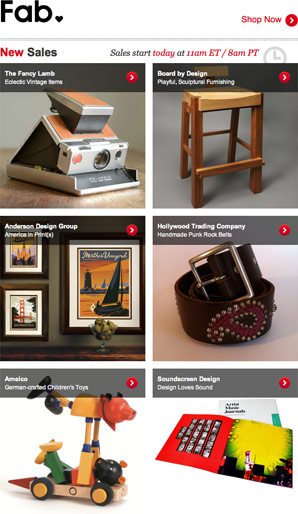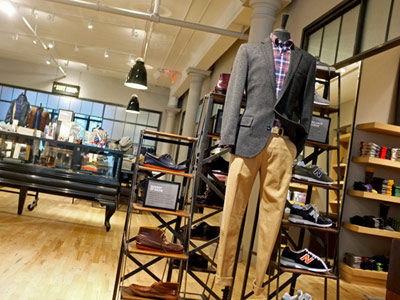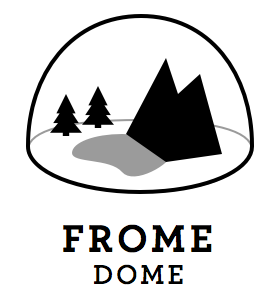Commerce as content, shopping through art
 While I was researching e-commerce sites for a project a couple of months ago, I signed up for a bunch of email newsletters from flash sales and group buying sites.
While I was researching e-commerce sites for a project a couple of months ago, I signed up for a bunch of email newsletters from flash sales and group buying sites.
Many of them contained lame deals or were ugly or boring, so I’ve unsubscribed.
But one of them, Fab.com’s daily email, has become a favorite. (Fab is still “by invitation only,” but if you’re interested, you can sign up here through my special link. If enough people do, I’ll get a few bones.)
Fab’s email is more than an advertisement of its flash sales, which include discounts on cool, design-y gadgets, housewares, clothing, art, etc. It’s also a beautiful piece of content delivered to me every day for free: A newsletter full of pretty photos of cool stuff, with a simple, clean layout. Of the dozens of emails that appear in my inbox in the morning, it’s one of the few that I actually enjoy opening and reading.
For me, the Fab newsletter serves the same purpose as reading design magazines or lifestyle blogs, in the sense that I can learn about cool things I didn’t previously know about. The big difference, of course, is that I can easily buy the things I’m reading about, if I want to. That’s useful for me, because it means I don’t have to figure out how and where to buy something that I like from the newsletter. And it has to be useful for Fab, because selling stuff to me seems like a better business than if it were just serving up ads for someone else’s store.
It’s a great example of the ever-blurring lines between commerce and editorial. And my enjoyment may be evidence that the best wave of new e-commerce companies may also be the ones that are great content producers. That means: Clear writing, attractive photography, and good design. I haven’t done the math, but it seems to me that great content with devoted readers could be a heck of a lot more effective at generating sales than just buying banner ads on random websites.
Fab, obviously, isn’t the only company doing this:
- Gilt Taste has hired top food writers and editors — Ruth Reichl, Francis Lam, and Melissa Clark, among others — to write content that will ideally help it sell gourmet food online.
- One of Groupon’s early differentiators was that it had a crew of comedy writers creating its deal copy. (Meanwhile, I’m generally turned off by the boring stock photos in Groupon’s emails, and most of the deals themselves.)
- On the other hand, Scoutmob, another daily deals company, has nice photography and design, so I’ve remained a subscriber. People like looking at nice things.
- Thrillist figured this thing out the other way around, realizing that if it acquired an e-commerce company — JackThreads — and plugged it into its huge newsletter subscriber list, it could dramatically increase its sales.
Heck, this isn’t even a new idea. For years, I loved receiving Design Within Reach’s “Design Notes” email, especially when its annual champagne mini-chair design contest rolled around. And it’s been going on offline, too: When I was in high school in the late 1990s, Abercrombie’s A&F Quarterly was actually a decent lifestyle magazine/catalog, before the whole company changed genres and lost my attention. Swedish denim company Acne’s magazine, Acne Paper, is one of the most influential indie pubs out there, according to my fashion-editor wife.
 And really, it makes sense.
And really, it makes sense.
Producing great editorial content and a great retail experience are similar art forms, involving common skills and traits, like editing, point-of-view, design, and production.
It’s why a visit to one of J.Crew’s newish Men’s Shops is just as enjoyable to me as reading a great magazine. (Now there’s an idea — how about a men’s glossy edited by Mickey Drexler?)
And, moreover, both types of companies have similar goals: To delight their audience and to sell stuff. Most decent efforts can do one or the other. The great ones do both.
It’s why I think many of the most interesting — and possibly the most successful — new e-commerce ventures could be the ones that are also producing the best content. At least those are the ones I’d want to do business with.
Great editorial obviously doesn’t guarantee a commerce company will do great business. But with all the growth in social and online media, and gorgeous color screens in everyone’s pocket and backpack, I think they’re more closely related than ever.

Check out my new site: The New Consumer, a publication about how and why people spend their time and money.

